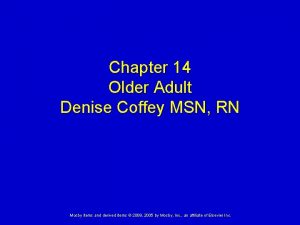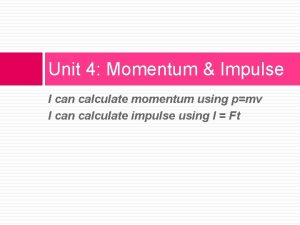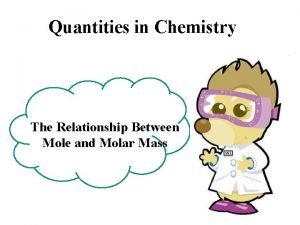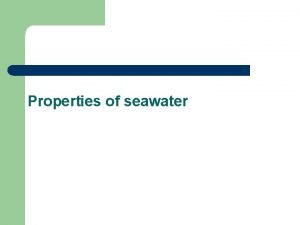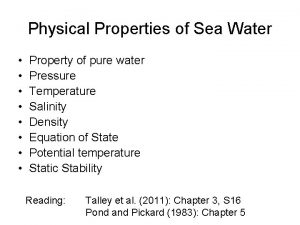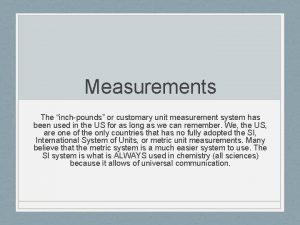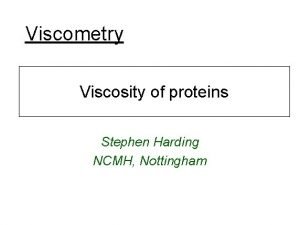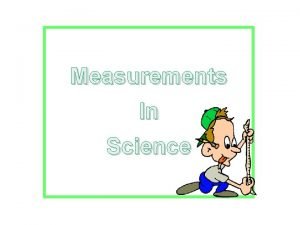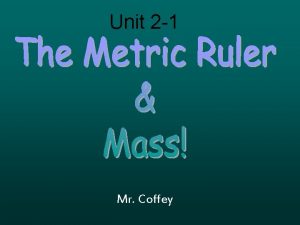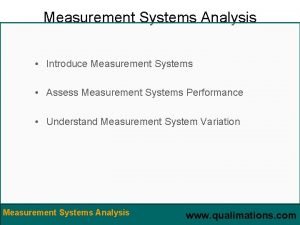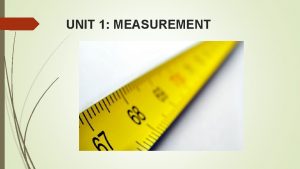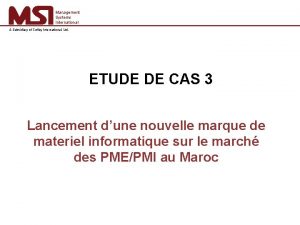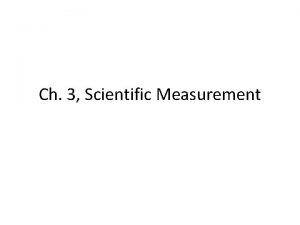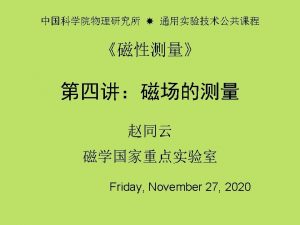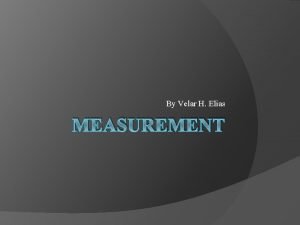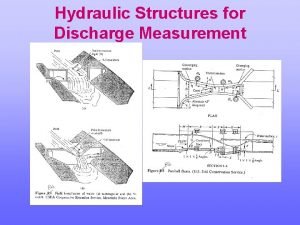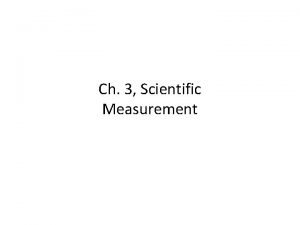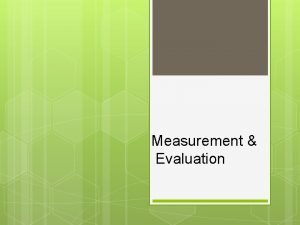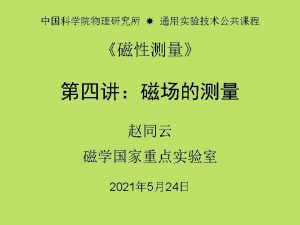Unit 2 2 Mr Coffey Systems of Measurement
















- Slides: 16

Unit 2 -2 Mr. Coffey

Systems of Measurement • The English system is used in the United States. • The units used are gallons, pounds, and feet. • There are no standards in nature for these units. • The rest of the world uses another measurement system: the metric system.

The Metric System • The metric system is based on multiples of 10 (such as 100 and 1, 000). • Scientists all over the world use metric units. • This allows them to share scientific knowledge even when they speak different languages. • There is an International System of Units called the SI Units: meter, liter, and gram.

SI Units: Length • The basic unit of length in science is called the meter (m). A metric ruler is a ruler that scientists use to measure length.

Metric Ruler • Used to measure length (meters) Metric Units = GOOD! English = BAD

SI Units: Volume • The basic unit of volume to measure gasses and liquids is called the liter (l). A graduated cylinder is a tool scientists use to measure liquid volume.

SI Units: Mass • The basic unit of mass in science is called the gram (g). A triple beam balance is a tool scientists use to measure mass.

SI Units Standard International Units (SI) are units that are used for consistency all around the world. Measurement Unit Symbol Length Meter m Mass Gram g Volume Liter L Time Second sec Temperature Celsius °C

Prefixes help to make measurement of lengths, volumes, and mass more accurate by making the root measurements (m, l, g) bigger or smaller. Prefix Symbol Equivalent Kilo K 1, 000 Hecto H 100 Deka Da Deci d . 1 Centi c . 01 Milli m . 001 10. 1 = 1/10. 01 = 1/100. 001 = 1/1000

Let’s do an example! Prefix Symbol Comparison Kilometer km 1. 6 km = 1 mile Hectometer hm 1 hm is the length of 2. 5 planes Dekameter dam 1 dam is the size of a schoolbus Decimeter dm 1 dm is the size of a scotch tape dispenser Centimeter cm 2. 5 cm is the diameter of a quarter Millimeter mm 1 mm is the thickness of a dime

Using Steps

Understanding Unit Conversions King Henry Doesn’t (usually) Drink Chocolate Milk K H D Kilo Hecto Deka 1000 10 unit d c deci centi 0. 1 grams (g) liters (l) meters (m) 0. 01 m milli 0. 001 • The difference between each unit is one decimal place, or 10. • As you go from larger units to smaller units, move the decimal place to the right. • As you go from smaller units to larger units, move the decimal place to the left.

Using a CHART: Used to measure bigger things!! Kilo Hecto Deka - Moving to the left is like dividing. - Your number will get SMALLER (become a decimal) Used to measure smaller things!! m/l/g deci centi milli - Moving to the right is like multiplying. -Your number will get BIGGER! You will move your decimal point in the same direction that you moved on the chart!

How we do it…. . 2. 345 Convert: 23. 45 mm to _______ cm Kilo Hecto Deka m/l/g deci centi milli

Now Try These…. 1) 1000 mg = _______ g 2) 1 L = _______ m. L 3) 160 cm = _______ mm 4) 14 km = _______ m 5) 109 g = _______ hg 6) 250 m = _______ km 7) 6 L = _______ m. L

Now Try These…. 1. 0 g 1) 1000 mg = _______ 1, 000. 0 m. L 2) 1 L = _______ 1, 600. 0 mm 3) 160 cm = _______ 14, 000. 0 m 4) 14 km = _______ 1. 09 hg 5) 109 g = _______ 0. 250 km 6) 250 m = _______ 6, 000. 0 m. L 7) 6 L = _______
 Aoife coffey
Aoife coffey Is jennifer coffey engaged
Is jennifer coffey engaged Denise coffey death
Denise coffey death Denise coffey
Denise coffey Adam coffey
Adam coffey Vernon coffey
Vernon coffey Unit 6 review questions
Unit 6 review questions Momentum units physics
Momentum units physics Unit of moles
Unit of moles Mole unit of measurement
Mole unit of measurement Salinity unit of measurement
Salinity unit of measurement Physical properties of seawater
Physical properties of seawater Unit of measurement for power
Unit of measurement for power Unit of measurement for power
Unit of measurement for power Ostwald viscometer
Ostwald viscometer Miniature inertial measurement unit
Miniature inertial measurement unit A measurement includes both a number and a unit.
A measurement includes both a number and a unit.


